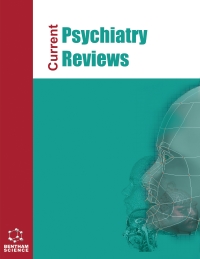- Home
- A-Z Publications
- Current Psychiatry Reviews
- Previous Issues
- Volume 14, Issue 4, 2018
Current Psychiatry Reviews - Volume 14, Issue 4, 2018
Volume 14, Issue 4, 2018
-
-
Transcranial Direct Current Stimulation for Treatment of Auditory Hallucination: A Systematic Review of Clinical Efficacy
More LessAuthors: Golshan Mirmomeni, Soheila Nikakhlagh, Nader Saki and Arash BayatBackground and Objective: Transcranial direct current stimulation (tDCS) is a safe and cost-effective stimulation technique that has drawn great attention as a potential therapeutic modality for auditory hallucination (AH). This review aims to bring together the evidence from randomized clinical trials (RCTs) on the effectiveness of tDCS for the treatment of AH in schizophrenia. Method: Eligible articles were identified throug Read More
-
-
-
Transcranial Direct Current Stimulation for the Treatment of Depressive Disorders: A Review of Clinical Applications
More LessBackground and Objective: Preclinical and clinical studies have demonstrated promising therapeutic effects of transcranial direct current stimulation (tDCS) for depressive disorders (DDs). Although food and drug administration has not approved tDCS as a clinical treatment option for DDs, clinical outcomes of the initial studies indicate significant therapeutic efficacy of tDCS which has encouraged further studies to dev Read More
-
-
-
Transcranial Direct Current Stimulation for Treatment of Alzheimer’s Disease: A Systematic Review of Randomized Clinical Trial
More LessAuthors: Miguel Mayo-Yáñez, Tania Corrás and Rebeca Méndez-IglesiasIntroduction: Alzheimer’s disease (AD) is a neurodegenerative pathology manifested by cognitive impairment and behavioral derangement. Transcranial Direct Current Stimulation (tDCS) as non-invasive and safe neuromodulation technique has shown promising effects in different neuropsychiatric disorders. Similarly, tDCS has recently shown potential therapeutic outcomes in AD. The present study aims to systema Read More
-
-
-
Transcranial Direct Current Stimulation for Treatment of ADHD: A Review of the Mechanisms of Action
More LessAuthors: Maryam Mirzaiyan, Pramod S Kunwar, Rosette Uzayisenga and Samaneh RashidiBackground and Objective: Attention deficit hyperactivity disorder (ADHD) is a common neuropsychiatric disorder. The current pharmaceutical treatments are associated with side effects and with low efficacy so that about one third of the adults do not respond to these treatments. Transcranial direct current stimulation (tDCS) is a non-invasive and safe brain modulation technique with promising therapeutic effects o Read More
-
-
-
Transcranial Direct Current Stimulation for the Treatment of Addictions: A Systematic Review of Clinical Trials
More LessAuthors: Ali Yadollahpour and Tifei YuanBackground and Objective: Addiction is one of the main health issues worldwide. Severe side effects and nonspecific actions of conventional medications have necessitated the development of new safe and non-invasive modality for addiction treatment. Transcranial direct current stimulation (tDCS) has shown potential treatment effects in substance use disorder and addiction. The present study aims to review the Read More
-
-
-
Transcranial Direct Current Stimulation in Psychiatric Disorders: A Comprehensive Review of Recent Advances
More LessBackground and Objective: Transcranial direct current stimulation (tDCS) has shown therapeutic efficacy in different psychiatric disorders including depression, attention deficit hyperactivity disorder (ADHD), cognitive functions in healthy subjects have made this technique an interesting research option for developing non-medication techniques for a variety of psychiatric disorders. This paper aimed to comprehensively review the Read More
-
-
-
Biomarkers of Major Depression Related to Serotonin Receptors
More LessAuthors: Meysam Amidfar, Lejla Colic, Martin Walter and Yong-Ku KimBackground: Developing group of recent findings demonstrate that serotonin receptors play a significant pathophysiological role in major depressive disorder (MDD). Objective: This article will briefly review the literature concerning mechanisms of action, brain distribution and localization of 5HT receptor subtypes and their changes in patients with MDD, as reported via neuroimaging, postmortem and genetic st Read More
-
-
-
Crisis and the Neurobiology Involved in the Development of Consequent Mental Illness
More LessAuthors: César Portela and Raquel R. SilvaBackground: Crisis as a topic in mental health is more relevant than ever. There are rapid changes happening in the world, involving politics, education, migration and so on. All these new events have consequences over mental health, at the short and long terms. Objective: Accomplish the need to understand the neuronal mechanisms underlying an illness after a crisis event, as well as a better guidance of the therapeut Read More
-
-
-
Cognition is a Necessary Factor for Controlling Drug Abuse
More LessAuthors: Hamidreza Famitafreshi and Morteza KarimianBackground: Drug abuse is one of the major concerns of human societies. The relapse of abusing drugs is one of the main targets of addiction therapies. Studies in this regard have introduced four basic mechanisms: 1) drug-induced reinforcement 2) cue-induced reinforcement 3) stress-induced reinforcement and 4) negative reinforcement. Objective: In recent studies, cognition has got great interest in addiction researc Read More
-
Most Read This Month
Article
content/journals/cpsr
Journal
10
5
false
en


